Amidst the bustling rhythm of Saigon, Giac Lam Pagoda emerges as an oasis of peace, preserving profound historical and Buddhist cultural values. With over 300 years of history, this pagoda is not only a sacred place of worship but also a unique architectural and artistic heritage, witnessing the city’s many ups and downs. Join “Du lịch khắp thế gian” (Travel Around The World) to explore Giac Lam Pagoda, feel the tranquility amidst the noisy urban center, and learn more about the stories hidden behind its moss-covered tiles.
Location and Contact Information of Giac Lam Pagoda
Giac Lam Pagoda is located at 565 Lac Long Quan Street, Tan Binh District, Ho Chi Minh City. This location is not only convenient for transportation but also situated in an area with many other attractions, making it ideal for tourists to combine visits to nearby destinations. From the city center, you can easily reach the pagoda by motorbike, car, or public transport such as buses.
Contact Information:
- Address: 565 Lac Long Quan, Ward 10, Tan Binh District, Ho Chi Minh City
- Phone: 028 3865 3933
- Opening Hours: 7:00 AM – 9:00 PM daily
As one of the oldest and largest pagodas in Saigon, Giac Lam Pagoda has been recognized by the Ministry of Culture and Information (now the Ministry of Culture, Sports and Tourism) as a National Historical and Cultural Relic. This further affirms the great historical, cultural, and architectural value of the pagoda in the hearts of Vietnamese people.
History of Formation and Development of Giac Lam Pagoda
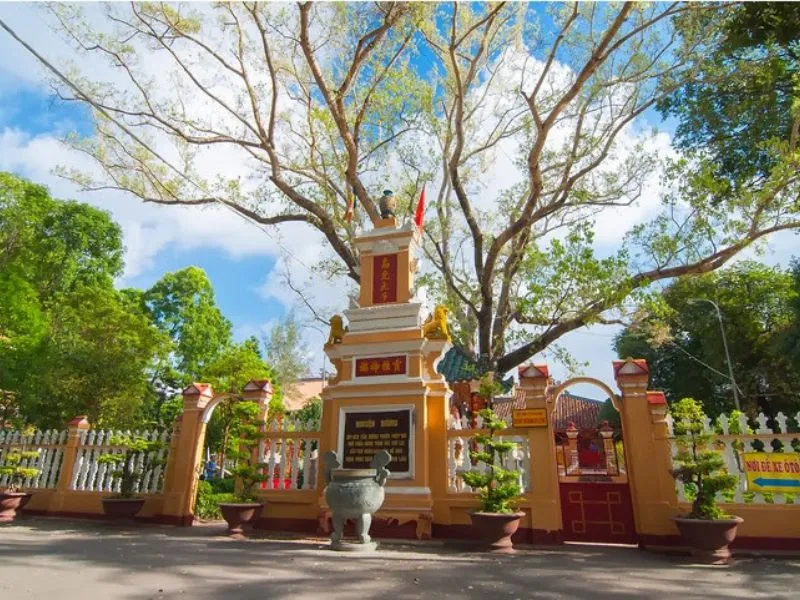
Giac Lam Pagoda, also known as Phat Bao Pagoda, is one of the oldest pagodas in Saigon, dating back 300 years. The pagoda is not only a familiar spiritual destination for locals but also attracts a large number of pilgrims and tourists from all over to visit, worship, and learn about Vietnamese Buddhist history.
Early Stage (1744 – 1827):
Giac Lam Pagoda was first built in the spring of 1744 by layman Ly Thuy Long during the reign of Lord Nguyen Phuc Khoat. Initially, the pagoda had simple names such as Cam Son, Son Can, or Cam Dem, reflecting the terrain and landscape where it was located. At this time, the pagoda served as a small Buddhist facility, catering to the religious needs of the local community.
Development and Renaming Period (1827 – 1945):
A significant turning point in the history of Giac Lam Pagoda occurred when Zen Master Phat Y-Linh Nhac sent his disciple, Zen Master Vien Quang, to take over. Zen Master Vien Quang renamed the pagoda Giac Lam, meaning “enlightenment in the forest” or “enlightened forest,” expressing the aspiration to propagate Buddhism and enlighten spirituality. Under the leadership of Zen Master Vien Quang, Giac Lam Pagoda quickly developed into a major Buddhist training center, where scriptures and precepts were disseminated to Buddhists throughout Gia Dinh and Southern Vietnam.
Resistance and Restoration Period (1945 – present):
During the resistance wars against the French and Americans (1939-1945), Giac Lam Pagoda became a secret location, sheltering and nurturing many revolutionaries. The pagoda made a significant contribution to the struggle for national independence. After the war, Giac Lam Pagoda continued to be restored and preserved to maintain its precious historical and architectural values.
Over nearly three centuries, Giac Lam Pagoda has witnessed many historical changes, from the Nguyen Lords era, through the French colonial period, to the resistance and nation-building phase. Despite the passage of time, the pagoda has maintained its position as a major Buddhist center and an important historical and cultural relic of Saigon.
Abbot Generations:
Since its establishment, Giac Lam Pagoda has had eight generations of abbots, each making important contributions to the maintenance and development of the pagoda. The current abbot is Venerable Thich Hue Trung, the resident monk is Reverend Thich Tu Tanh, and the vice abbot is Reverend Thich Tu Tri. The current monks and nuns continue the mission of propagating Buddhism, guiding Buddhists in practice, and preserving the cultural heritage of the pagoda.
Today, Giac Lam Pagoda remains a spiritual destination attracting thousands of tourists and Buddhists each year. Coming to the pagoda, visitors not only admire its unique architecture and peaceful space but also have the opportunity to learn about history, Buddhist culture, and profound humanistic values.
Unique Southern Architectural Style at Giac Lam Pagoda
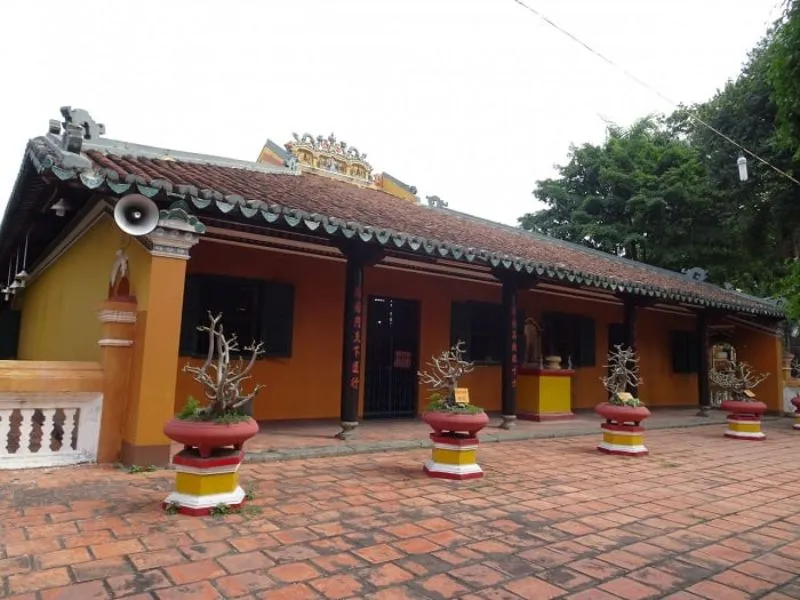
Giac Lam Pagoda is a valuable architectural and artistic museum, clearly reflecting the traditional architectural style of ancient Southern Vietnamese pagodas. The pagoda not only impresses with its ancient and solemn beauty but also contains deep cultural and religious values.
Tam-Shaped (Ξ) Layout:
Giac Lam Pagoda is built in a Tam-shaped (Ξ) layout, a common architectural style of pagodas in Southern Vietnam. This layout consists of three horizontal rows of houses connected to each other, creating a harmonious and balanced rectangular architectural complex. The main rows of houses include the main hall, lecture hall, and monks’ quarters, arranged scientifically to fully meet the functions of a traditional pagoda.
Nhi Quan Gate – Cultural Fusion:
The Nhi Quan Gate of Giac Lam Pagoda was built in 1945, bearing a unique architectural imprint. The highlight of the gate is the image of two majestic stone lions guarding both sides, reflecting the influence of Indian culture in Buddhist architecture. In addition, the Naga snake head image on the gate carries a strong Khmer cultural touch, creating a unique cultural intersection. The Nhi Quan Gate is designed in a kneeling style, with sophisticated embossed floral patterns, demonstrating the talent of ancient artisans. On the gate is also engraved a Han script line telling the legend of Prince O Quan of the Tang Dynasty, adding cultural and historical value to the structure. Notably, the Nhi Quan Gate is not built in line with the main hall, according to traditional feng shui beliefs, to prevent the intrusion of “evil spirits” into the most sacred area of the pagoda.
Tam Quan Gate – Simple and Welcoming Beauty:
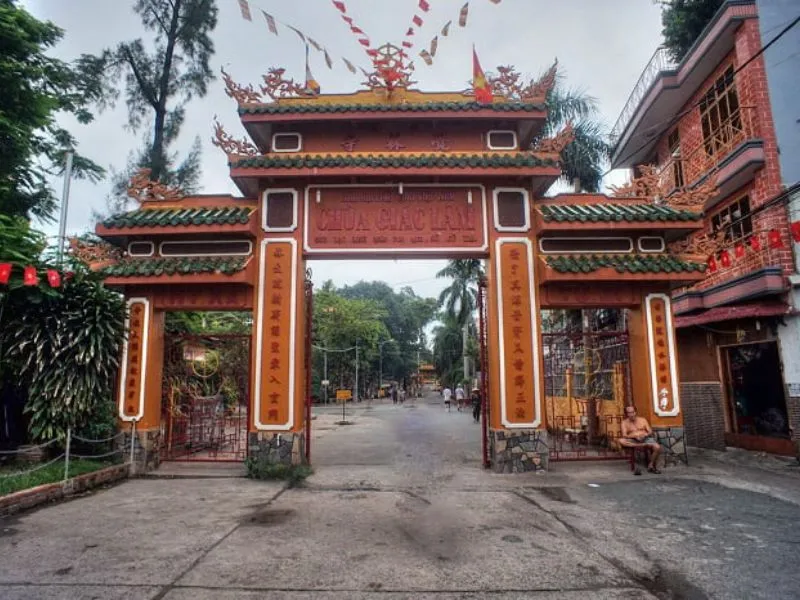
Unlike the Nhi Quan Gate, the Tam Quan Gate of Giac Lam Pagoda was built later, in 1955. The Tam Quan Gate has a simple and welcoming architectural style, reflecting the openness of Buddhism. The gate faces south, adjacent to Lac Long Quan Street, creating convenience for people and tourists to visit the pagoda. On both sides of the gate pillars are carved parallel sentences in Han script, carrying profound Buddhist doctrines. The Tam Quan Gate is always wide open, welcoming everyone to learn about and practice Buddhism.
Roof – Familiar Banh It Image:
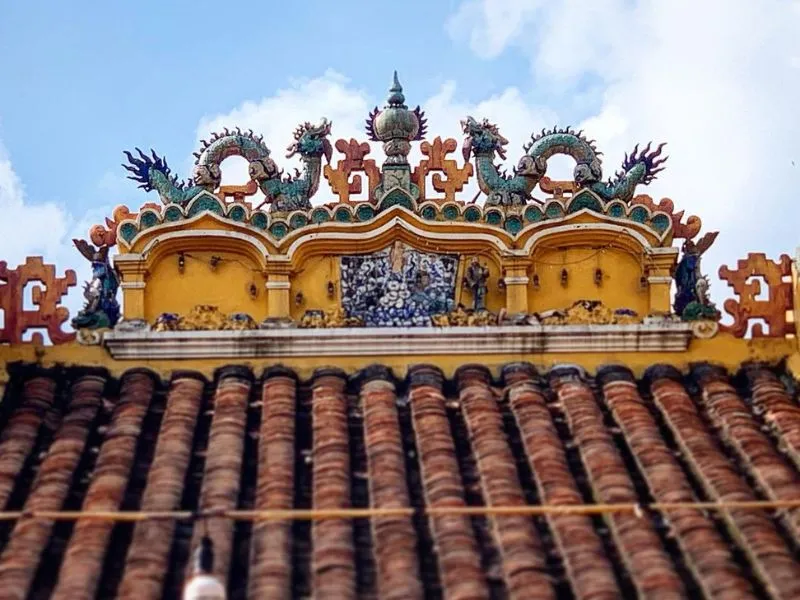
The roof of Giac Lam Pagoda is designed in the style of a “banh it” cake, a popular roof style in Southern architecture. This roof style creates a familiar and friendly feeling, reminiscent of the rustic banh it cake of the Southern countryside. The pagoda roof has four slopes, straight and without curved eaves like the communal house roofs of Northern Vietnam, bringing a graceful and gentle beauty. On the top of the roof is decorated the image of “twin dragons flanking a pearl,” symbolizing strength, authority, and reverence for Buddhist teachings.
Main Hall Area – Majesty and Grandeur:

The main hall area is the center of Giac Lam Pagoda, where the main worship activities take place. The main hall has a large and imposing space, reflecting the majesty and solemnity of Buddhism. In front of the main hall is a spacious rectangular courtyard, where altars are placed for Amitabha Buddha, Shakyamuni Buddha, Maitreya Buddha, and two side altars for Avalokiteśvara and Mahasthamaprapta Bodhisattvas. Inside the main hall, the Buddha worship space is solemnly decorated, with three altars arranged in descending order: Amitabha altar, Hoi Dong altar, and Tam Bao altar.
The main hall of Giac Lam Pagoda is built with a system of four main pillars (tu tru), symbolizing “worship Buddha first, then worship Ancestors,” expressing gratitude to the Buddha and the patriarchs. In addition, the main hall has a total of 56 large and small pillars, each meticulously crafted, carved with parallel sentences and decorated with luxurious gold leaf. Between the rows of pillars are also carved traditional decorative motifs such as the four sacred animals (dragon, unicorn, turtle, phoenix), the four noble plants (pine, chrysanthemum, bamboo, apricot), flowers and birds, creating a unique artistic space.
The worship area inside the main hall of Giac Lam Pagoda is extremely splendid and magnificent, with many large statues arranged harmoniously. Here, visitors can admire the statues of Amitabha Buddha, Shakyamuni Buddha, Maitreya Bodhisattva, Mahasthamaprapta Bodhisattva, Avalokiteśvara Bodhisattva, along with the Nine Dragons statue set cast from exquisite bronze. A special feature of the main hall is the presence of two sets of Eighteen Arhat statues and two sets of Ten Kings of Hell statues, creating richness and uniqueness for the worship space.
Another unique architectural highlight of the main hall of Giac Lam Pagoda is the top of the wall and Hong Hung ancestral tower decorated with more than 7,000 porcelain plates. Of these, more than 6,000 plates are used to decorate the main hall walls and more than 1,000 are in the Hong Hung ancestral tower. These decorative plates are mainly produced from the Lai Thieu pottery kiln (Binh Duong), along with some plates imported from Japan and China. Thanks to this record number of decorative plates, Giac Lam Pagoda has been recognized as the pagoda “with the most decorative plates in Vietnam.”
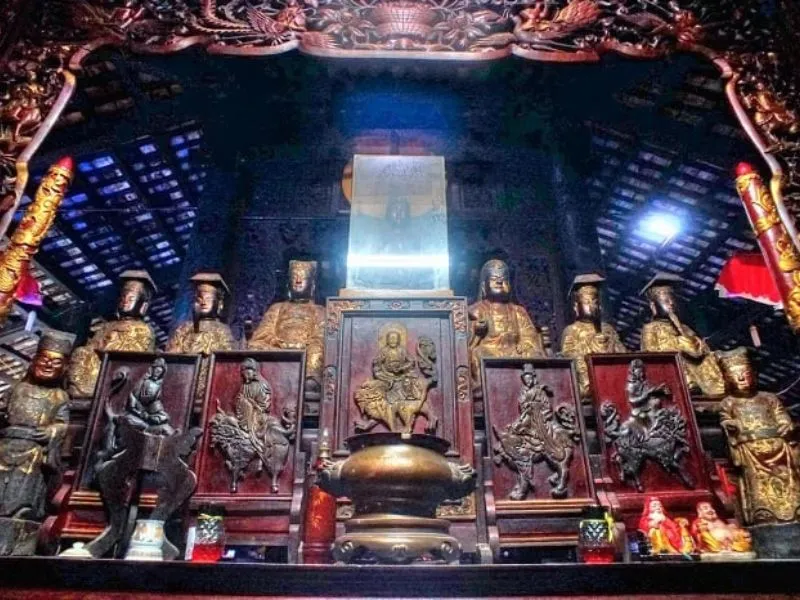
Behind the main hall area is the ancestral altar area, where the abbots of the pagoda through the ages are honored. Opposite the ancestral altar is the altar of Cundi Buddha, Amitabha Buddha, and the Ten Kings of Hell. Near the ancestral altar area is the lecture hall, built in the style of the main hall roof. This is where monks, nuns, and Buddhists often attend important events and major festivals at Giac Lam Pagoda. During the resistance wars against the French and Americans, the lecture hall was also used as a training place for cadres and to deploy reconnaissance work in the inner city.
Other Highlights and Attractions at Giac Lam Pagoda
In addition to its unique architecture, Giac Lam Pagoda also possesses many other valuable structures and artifacts, attracting the attention of tourists and researchers:
Ancient Tomb Tower Area:
The ancient tomb tower area at Giac Lam Pagoda was built from the early 19th century to the early 20th century, serving as the resting place for Zen masters and monks who contributed to the pagoda. The tomb towers have many different architectural styles, reflecting the diversity and richness of traditional tomb tower construction art. The ancient tomb tower area is not only part of the pagoda’s architectural heritage but also a sacred space, commemorating and honoring the merits of predecessors.
Stupa of Relics – Unique Architecture:
The Stupa of Relics is a prominent architectural structure in the Giac Lam Pagoda campus. The stupa is built in a hexagonal shape, consisting of seven floors, starting construction in 1970 according to the design of architect Vinh Hoang. Construction was interrupted in 1975 and completed in 1994. The stupa is 32.7m high and covers an area of more than 600m2, facing north.
The ground floor of the stupa houses an altar for the Amitabha Trinity, and the upper floors enshrine many Buddha and Bodhisattva statues such as Shakyamuni Buddha, Medicine Buddha, Avalokiteśvara Bodhisattva, etc. The top floor is decorated with a Nine Dragons chandelier, with the relics of Shakyamuni Buddha in the center. The Stupa of Relics is not only a place to worship Buddha’s relics but also a unique architectural work of art, contributing to enriching the landscape and cultural value of Giac Lam Pagoda.
119 Statues Worship Area – Buddha Statue Museum:
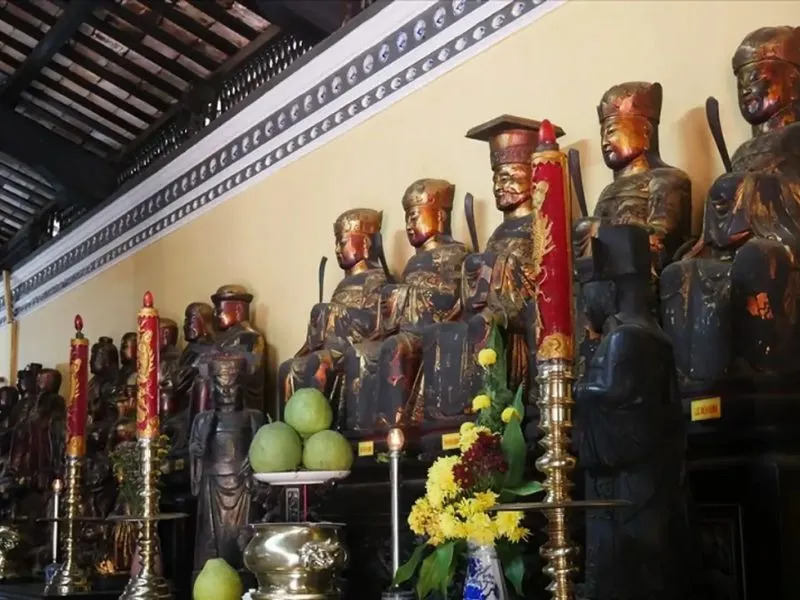
Giac Lam Pagoda is known as a “Buddha statue museum” with a worship area of 119 precious statues. This statue collection includes many different types of statues, such as wooden Shakyamuni statues, bronze infant Shakyamuni statues, Eighteen Arhat statues, Five Wise Men statues, etc. In particular, the Eighteen Arhat statue set is considered a clear symbol of the development of Southern Buddhism and the cultural characteristics of Vietnamese people. In addition to Buddha statues, the pagoda also preserves many other precious wooden artifacts such as valances, horizontal lacquered boards, gold-plated parallel sentences, altars, and ancient worship items, creating a rich and diverse artistic space.
Participate in Festivals and Spiritual Activities at Giac Lam Pagoda
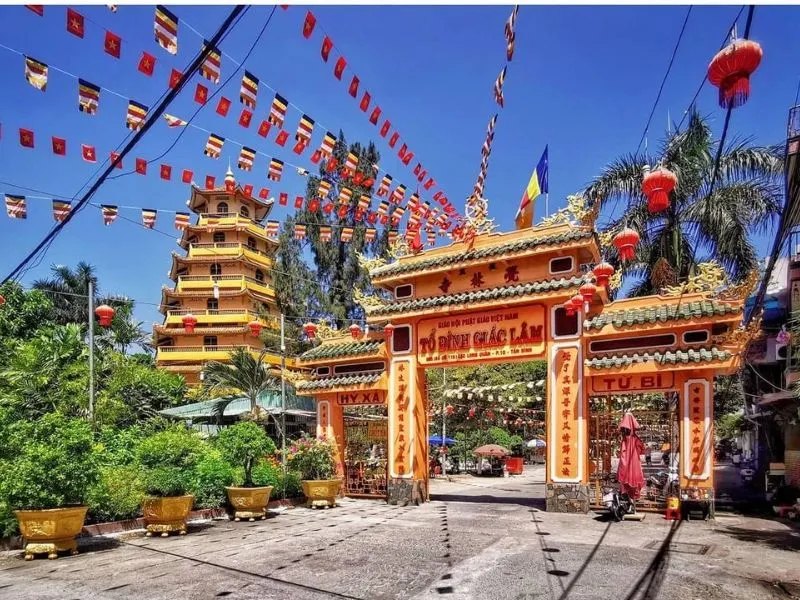
Giac Lam Pagoda is not only a tourist attraction but also an important cultural and spiritual activity center for the people of Saigon. On major holidays such as the first full moon of the year, the full moon of July (Vu Lan festival), and Buddha’s Birthday, the pagoda attracts a large number of monks, nuns, Buddhists, and tourists to attend. This is an opportunity for you to immerse yourself in a solemn and respectful atmosphere, participate in Buddhist ceremonies, and pray for peace and luck for yourself and your family.
In addition to traditional festivals, Giac Lam Pagoda also organizes many special religious activities such as Buddha’s Birthday celebrations, Vu Lan festival, New Year’s peace prayers, lucky calligraphy wishes, etc. Visitors can also participate in short-term retreats or Buddhist Dharma talks to learn more about Buddhism and cultivate their minds. Participating in these activities not only helps you have meaningful spiritual and cultural experiences but also creates opportunities to calm your mind, relax, and find balance in life.
Conclusion
Giac Lam Pagoda in Saigon is not only an ancient pagoda with unique architecture but also a precious cultural and historical heritage of the nation. Coming to Giac Lam Pagoda, visitors not only admire the architectural beauty and learn about history but also feel the peace and tranquility in their souls. Take the time to visit Giac Lam Pagoda to discover its profound cultural and spiritual values and enjoy the peaceful space in the bustling heart of Saigon. Surely, the experiences at this 300-year-old pagoda will leave an unforgettable impression on every visitor.